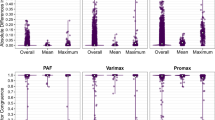Abstract
Three methods of rotation (the graphical, the Thurstone analytical, and the direct-rotational) were applied to the matrix of centroid loadings for 35 variables, to determine which method is the most efficient from theoretical and practical standpoints. The direct-rotational method provided the most information for determining the rank of the configuration and was most economical with respect to time required to reach a rotational solution. The analytical method required the least number of judgmental decisions and was the most objective. The graphical method was the most laborious but had a slight advantage with regard to the number of near-zero loadings in the rotational solution.
Similar content being viewed by others
References
Carroll, J. B. An analytical solution for approximating simple structure in factor analysis.Psychometrika, 1953,18, 23–38.
Fruchter, B. Orthogonal and oblique solutions to a battery of aptitude, achievement, and background variables.Educ. psychol. Measmt, 1952,12, 20–38.
Fruchter, B.Introduction to factor analysis. New York: Van Nostrand, 1954.
Harris, C. W. Direct rotation to primary structure.J. educ. Psychol., 1948,39, 449–468.
Harris, C. W. Projections of three types of factor patterns.J. exp. Educ., 1949,17, 335–345.
Harris, C. W. and Knoell, D. M. The oblique solution in factor analysis.J. educ. Psychol., 1948,39, 385–403.
Neuhaus, J. O. and Wrigley, C. The quartimax method: an analytical approach to orthogonal simple structure.Brit. J. statist. Psychol., 1954,7, 81–91.
Saunders, D. R. An analytical method for rotation to orthogonal simple structures. Educational Testing Service Research Bulletin, 53-10, August 1953.
Thurstone, L. L. An analytical method for simple structure.Psychometrika, 1954,19, 173–182.
Zimmerman, W. S. A simple graphical method for orthogonal rotation of axes.Psychometrika, 1946,11, 51–55.
Author information
Authors and Affiliations
Additional information
Systems Development Corp.
Rights and permissions
About this article
Cite this article
Fruchter, B., Novak, E. A comparative study of three methods of rotation. Psychometrika 23, 211–221 (1958). https://doi.org/10.1007/BF02289235
Received:
Revised:
Issue Date:
DOI: https://doi.org/10.1007/BF02289235




